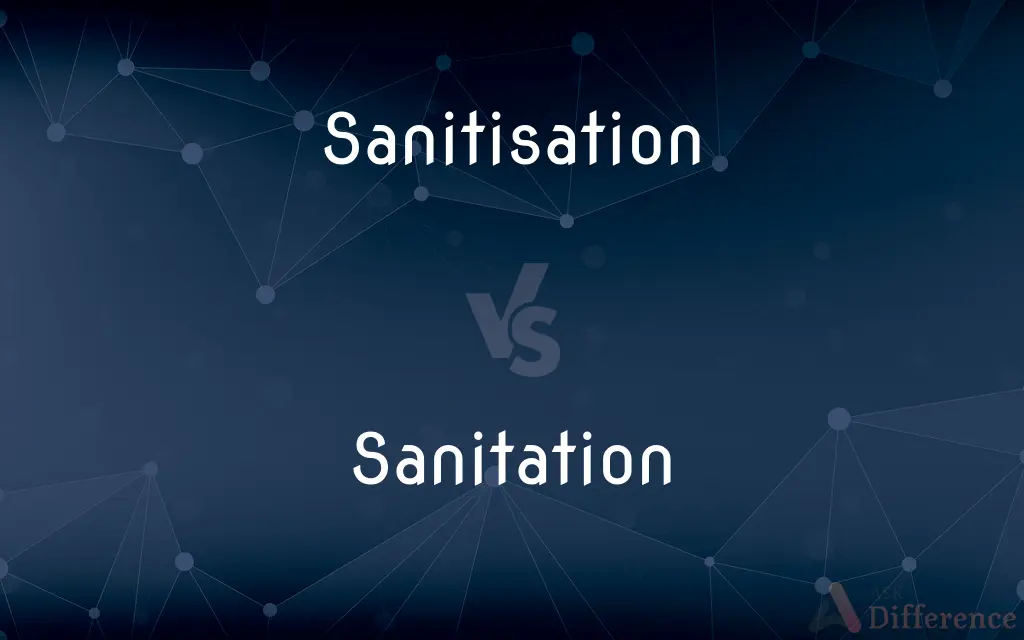Sanitisation vs. Sanitation — What's the Difference?
By Urooj Arif & Maham Liaqat — Updated on April 16, 2024
Sanitisation refers to the process of cleaning to reduce germs to a safe level, whereas sanitation encompasses broader public health systems like wastewater management.

Difference Between Sanitisation and Sanitation
Table of Contents
ADVERTISEMENT
Key Differences
Sanitisation primarily focuses on reducing the number of germs on surfaces or objects to a safe level, often through chemicals or heat. On the other hand, sanitation is a more encompassing term that includes the management of waste, public sewage, and water systems to prevent disease.
While sanitisation is frequently applied in healthcare, food preparation, and other settings where cleanliness is crucial, sanitation is a fundamental aspect of urban planning and public health infrastructure.
Sanitisation methods are typically immediate and localized, such as wiping a surface with disinfectants. Conversely, sanitation involves long-term strategies and infrastructures, such as sewage treatment plants and garbage disposal systems.
The goal of sanitisation is to make environments safer by significantly reducing pathogens that could cause infections. Whereas, sanitation aims to maintain a healthy environment through comprehensive waste management and water quality control.
Sanitisation can be a routine daily activity in homes and businesses, ensuring areas are safe and clean. On the other hand, sanitation requires government involvement and policy to implement large-scale systems that protect entire communities.
ADVERTISEMENT
Comparison Chart
Definition
Process of cleaning to reduce germs to a safe level
Management of waste and water for public health
Scope
Localized and immediate
Broad and long-term
Primary Settings
Homes, hospitals, restaurants
Cities, towns
Methods
Use of disinfectants, heat
Sewage systems, waste disposal
Objective
Reduce pathogens to prevent infection
Prevent disease through waste management
Compare with Definitions
Sanitisation
Reducing germs on surfaces or objects using chemicals or heat.
Sanitisation of the kitchen counters involves using bleach to kill bacteria.
Sanitation
Encompasses waste management and water treatment to prevent diseases.
Sanitation facilities in the city include several new wastewater treatment plants.
Sanitisation
The process aimed at achieving a safe level of microorganisms.
Regular sanitisation in hospitals helps in maintaining a sterile environment.
Sanitation
Integral to sustainable development and environmental health.
Proper sanitation helps in reducing environmental pollution.
Sanitisation
Focused on cleanliness.
Effective sanitisation techniques are crucial for infection control in clinics.
Sanitation
Involves policies and large-scale planning.
New sanitation policies have been implemented to address the growing needs of the urban population.
Sanitisation
Often a response to specific health threats.
During flu season, sanitisation of public spaces increases.
Sanitation
Required on a municipal or city level.
The government is planning a major upgrade of the sanitation infrastructure.
Sanitisation
Application in small-scale settings, like homes or restaurants.
Daily sanitisation of eating areas ensures food safety.
Sanitation
The development and implementation of public health systems related to cleanliness.
Effective sanitation systems are essential for urban public health.
Sanitisation
(British spelling) sanitization
Sanitation
Sanitation refers to public health conditions related to clean drinking water and adequate treatment and disposal of human excreta and sewage. Preventing human contact with feces is part of sanitation, as is hand washing with soap.
Sanitisation
Making something sanitary (free of germs) as by sterilizing
Sanitation
Conditions relating to public health, especially the provision of clean drinking water and adequate sewage disposal
They could afford to erect new dwellings with a reasonable standard of construction and sanitation
Sanitation
The study and application of procedures and measures designed to protect public health, as in the provision of clean water and the disposal of sewage and waste.
Sanitation
The disposal of sewage and waste.
Sanitation
The hygienic disposal or recycling of waste.
Sanitation
The policy and practice of protecting health through hygienic measures.
Sanitation
The act of rendering sanitary; the science of sanitary conditions; the preservation of health; the use of sanitary measures; hygiene.
How much sanitation has advanced during the last half century.
Sanitation
The state of being clean and conducive to health
Sanitation
Making something sanitary (free of germs) as by sterilizing
Common Curiosities
Why is sanitation important in urban areas?
It prevents the spread of diseases by properly managing waste and providing clean water.
Where is sanitisation most commonly used?
In healthcare, food service, and homes to maintain cleanliness and prevent disease.
Can sanitisation methods be part of sanitation?
Yes, sanitisation methods like treating water with chlorine are part of broader sanitation efforts.
What role do governments play in sanitation?
Governments develop and maintain waste management and water treatment infrastructures.
What are some common methods of sanitisation?
Using disinfectants, sterilization by heat, and using alcohol-based cleaners.
Are sanitisation products regulated?
Yes, products used for sanitisation are regulated by health authorities to ensure their effectiveness.
What is the main difference between sanitisation and sanitation?
Sanitisation reduces germs to safe levels typically through cleaning, while sanitation involves managing waste and water systems to maintain public health.
How does sanitisation affect individual health?
It directly reduces the risk of infection by eliminating pathogens from environments.
What is the global impact of inadequate sanitation?
It leads to increased disease, environmental degradation, and hampers economic development.
How often should sanitisation occur in public spaces?
It depends on the usage but generally, frequent sanitisation is recommended in high-traffic areas.
What is the environmental impact of sanitisation?
If not managed properly, sanitisation can lead to chemical pollutants in the environment.
Share Your Discovery

Previous Comparison
Social vs. Sociable
Next Comparison
Immunopositive vs. ImmunonegativeAuthor Spotlight
Written by
Urooj ArifUrooj is a skilled content writer at Ask Difference, known for her exceptional ability to simplify complex topics into engaging and informative content. With a passion for research and a flair for clear, concise writing, she consistently delivers articles that resonate with our diverse audience.
Co-written by
Maham Liaqat














































